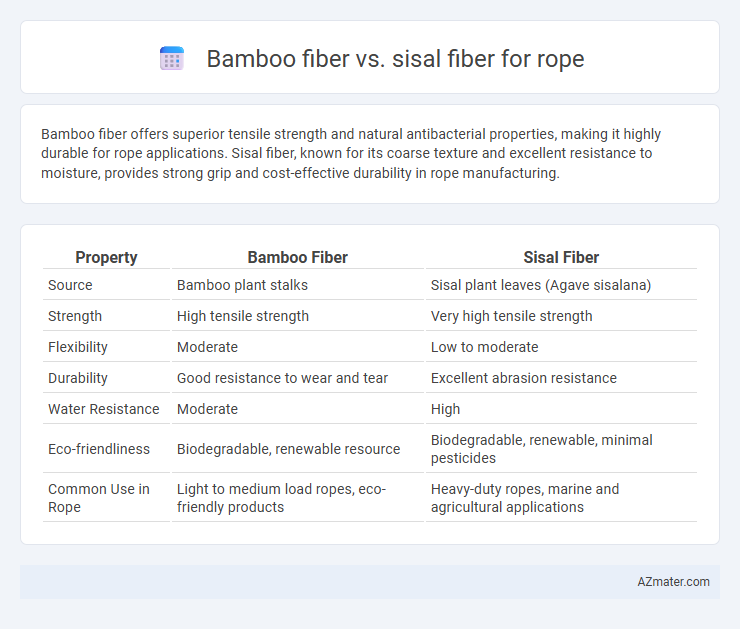Bamboo fiber offers superior tensile strength and natural antibacterial properties, making it highly durable for rope applications. Sisal fiber, known for its coarse texture and excellent resistance to moisture, provides strong grip and cost-effective durability in rope manufacturing.
Table of Comparison
| Property | Bamboo Fiber | Sisal Fiber |
|---|---|---|
| Source | Bamboo plant stalks | Sisal plant leaves (Agave sisalana) |
| Strength | High tensile strength | Very high tensile strength |
| Flexibility | Moderate | Low to moderate |
| Durability | Good resistance to wear and tear | Excellent abrasion resistance |
| Water Resistance | Moderate | High |
| Eco-friendliness | Biodegradable, renewable resource | Biodegradable, renewable, minimal pesticides |
| Common Use in Rope | Light to medium load ropes, eco-friendly products | Heavy-duty ropes, marine and agricultural applications |
Introduction to Bamboo and Sisal Fibers
Bamboo fiber, derived from the pulp of bamboo plants, is known for its natural strength, flexibility, and eco-friendly properties making it an excellent material for rope production. Sisal fiber, extracted from the leaves of the Agave sisalana plant, offers high tensile strength and durability, commonly used in industrial and agricultural ropes. Both fibers are renewable and biodegradable, but bamboo fiber provides a softer texture while sisal fiber excels in abrasion resistance.
Botanical Origins and Harvesting Processes
Bamboo fiber for rope is derived from the sturdy stalks of the Bambusoideae subfamily, predominantly harvested by cutting mature bamboo culms and extracting fibers through mechanical or chemical retting methods. Sisal fiber originates from the leaves of the Agave sisalana plant, where fibers are extracted via decortication, involving scraping to separate long, stiff fibers from the fleshy leaf material. Bamboo's rapid growth and perennial nature contrast with sisal's slower, agave-based cultivation, influencing harvesting cycles and fiber availability.
Fiber Structure and Composition Comparison
Bamboo fiber exhibits a hollow, tubular structure composed primarily of cellulose, hemicellulose, and lignin, lending it high tensile strength and flexibility ideal for rope making. Sisal fiber features a coarser, more rigid structure with a higher lignin content, providing excellent abrasion resistance but less elasticity compared to bamboo. The comparative chemical composition, including bamboo's lower lignin and higher cellulose ratios, results in enhanced softness and durability, making it suitable for fine, strong ropes.
Strength and Durability Factors
Bamboo fiber exhibits superior tensile strength compared to sisal fiber, making it ideal for heavy-duty rope applications requiring high load-bearing capacity. Sisal fiber, while slightly less strong, offers enhanced abrasion resistance and natural stiffness, contributing to long-lasting durability in outdoor and marine environments. Both fibers resist moisture and UV degradation, but bamboo's denser fiber structure provides increased longevity under repeated stress and environmental exposure.
Environmental Sustainability and Eco-Friendliness
Bamboo fiber and sisal fiber are both sustainable materials used in rope manufacturing, with bamboo fiber being rapidly renewable due to bamboo's fast growth rate and high carbon sequestration capacity. Sisal fiber, derived from the Agave sisalana plant, is biodegradable and requires minimal pesticides or herbicides, promoting eco-friendly farming practices. Both fibers contribute to reducing plastic reliance, though bamboo offers greater soil preservation benefits, while sisal excels in drought resistance, making their environmental impacts context-dependent.
Rope Performance in Various Applications
Bamboo fiber rope offers superior tensile strength and flexibility, making it ideal for heavy-duty applications such as marine and industrial use where durability and resistance to abrasion are crucial. Sisal fiber rope excels in outdoor and agricultural settings due to its natural resistance to moisture and UV degradation, providing excellent grip and environmental resistance. Both fibers provide eco-friendly alternatives, but bamboo fiber typically outperforms sisal in load-bearing capacity and longevity under harsh conditions.
Moisture Resistance and Weatherability
Bamboo fiber exhibits superior moisture resistance compared to sisal fiber, making it less prone to rot and mildew when used in rope applications exposed to damp environments. Sisal fiber, while strong and durable, tends to absorb more moisture, which can weaken the rope over time and reduce its lifespan in outdoor settings. Bamboo fiber also demonstrates better weatherability, maintaining structural integrity and flexibility despite prolonged exposure to sunlight and varying weather conditions.
Cost Effectiveness and Market Availability
Bamboo fiber offers higher cost effectiveness for rope production due to its rapid growth rate and lower processing expenses compared to sisal fiber, which requires more labor-intensive extraction. The market availability of bamboo fiber is expanding globally, driven by sustainable agriculture practices, while sisal fiber remains regionally concentrated, primarily in East Africa and Brazil. Despite sisal's superior durability, bamboo fiber's competitive pricing and increasing supply make it a preferred choice for large-scale rope manufacturing.
Safety and Comfort Considerations
Bamboo fiber rope offers superior softness and flexibility, reducing skin irritation and enhancing user comfort during prolonged handling, making it ideal for safety-critical applications requiring gentle touch. Sisal fiber rope, known for its natural strength and rough texture, provides excellent grip and abrasion resistance but can cause discomfort or minor abrasions with extended contact. The choice between bamboo and sisal fibers for rope hinges on balancing comfort against durability, with bamboo fiber preferred for sensitive environments and sisal favored where ruggedness and grip paramount.
Choosing the Right Fiber for Rope Manufacturing
Bamboo fiber offers superior tensile strength and flexibility, making it ideal for high-performance ropes requiring durability and resistance to wear. Sisal fiber provides excellent abrasion resistance and natural stiffness, suitable for ropes used in marine and agricultural applications where grip and rigidity are essential. Selecting the right fiber depends on the rope's intended use, balancing factors like strength, durability, and environmental resistance specific to bamboo or sisal properties.

Infographic: Bamboo fiber vs Sisal fiber for Rope
 azmater.com
azmater.com